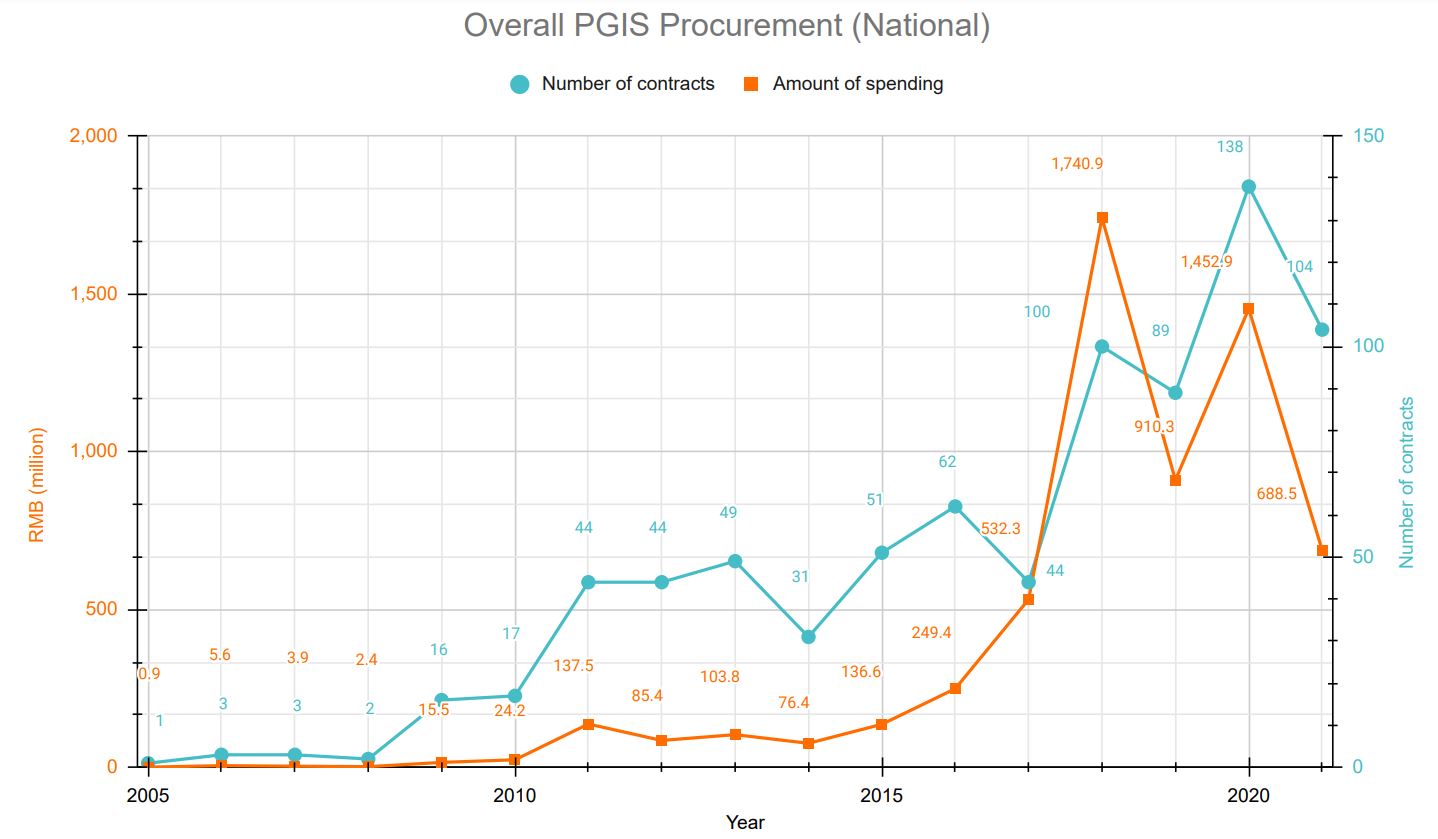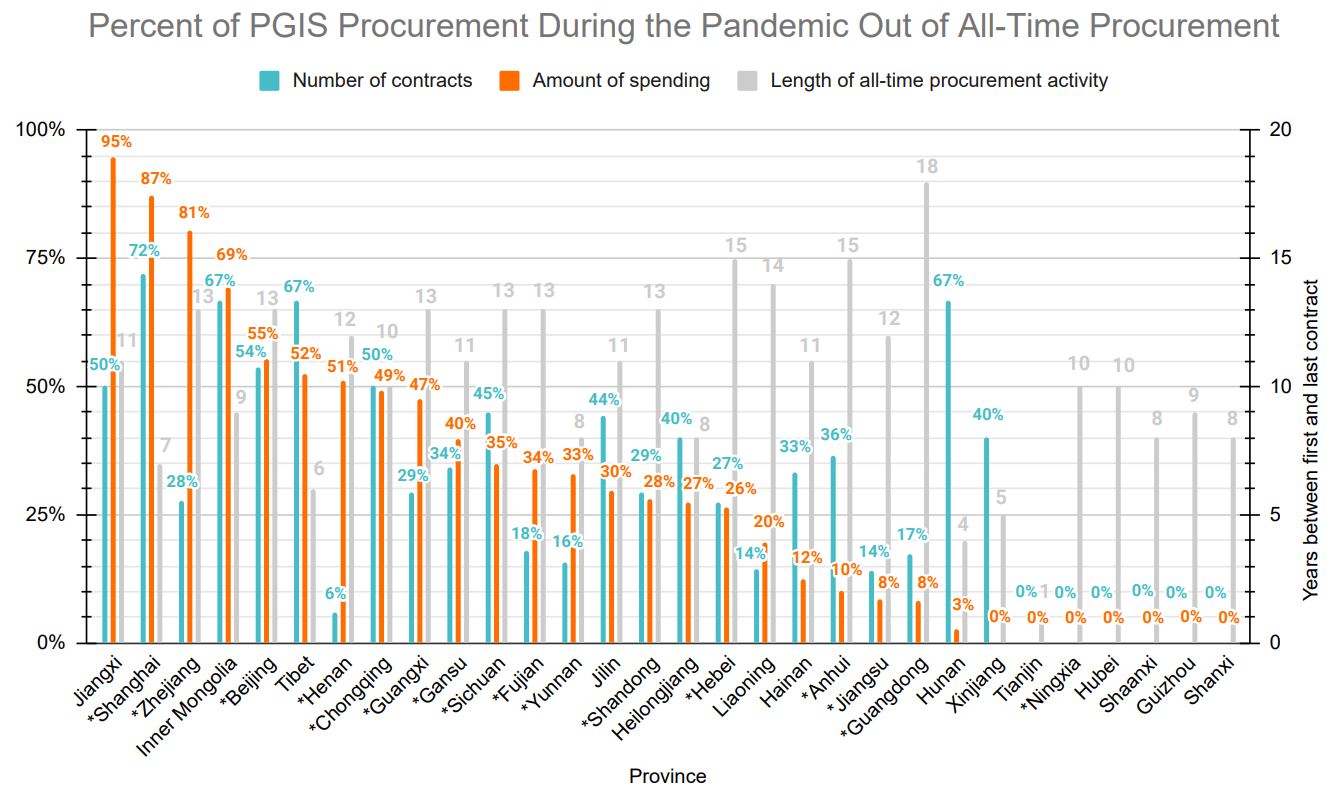The full report can be read in PDF form here. Below is a brief introduction.
A CDT investigation details the efforts of police and other departments across China to utilize geographic information systems (GIS) to enhance and coordinate surveillance capacity. Hundreds of government procurement records obtained and analyzed by CDT show that Chinese governments at various levels are building an expansive and sophisticated network of police geographic information systems (PGIS) with the intention of predicting and suppressing social unrest. Here are some of the main findings:
- From September 2005 to January 2022, governments across 30 provinces signed at least 803 PGIS contracts worth 6.2 billion RMB.
- In most provinces and many cities, PGIS procurement increased during the coronavirus pandemic. In 2020, average PGIS spending increased by almost 60 percent year-on-year, and the number of contracts reached an all-time high.
- Certain PGIS contracts solicited “smart” technologies and American technologies inaccessible to Chinese citizens. Others were signed with Chinese companies that previously had extensive access to the U.S. capital market.
- Some contracts coincided with other government purchases of surveillance systems specifically designed to target Uyghurs. There are also notable concentrations of procurement in regions with significant Uyghur or other minority populations.
GIS technology displays, stores, and analyzes geospatial data for purposes such as disease tracking or environmental monitoring. In the hands of law enforcement agencies, GIS can be used to coordinate police resources or to plot and visualize locations of unlawful activities, detect crime patterns, and create strategies for identifying suspects and deploying officers.
Chinese PGIS purchases made in recent years have focused on predictive policing, with the goal of improving the state’s ability to maintain “social stability.” Some of these PGIS contracts explicitly target petitioners and other “key persons” who are in practice defined as anyone deemed ideologically threatening to the state.
Our report provides an overview of the contents and geographic distribution of these PGIS contracts across Chinese provinces and cities, as well as their evolution over time. It also highlights numerous cities with high levels of total spending, spending on individual contracts, and spending per capita.
The PGIS contracts in our dataset appeared concentrated over one, if not two, major waves of procurement that span between 2017 and 2021. PGIS procurement appeared to spike at the same time that China’s annual GDP growth rate decreased to its lowest level since 1976. This is revealing of the Chinese state’s priorities.

Part of our report analyzes the change in PGIS procurement during the pandemic. The majority of PGIS contracts in our dataset were made by Public Security Bureaus, which were also responsible for enforcing pandemic control policies. The recent adoption of big data bureaus and cloud governance facilitated these enforcement efforts, and in some cases PGIS products were explicitly marketed to support such efforts. Media reports also documented an increase in police surveillance during the pandemic.
Our data indicates that not only was there a substantial amount of PGIS procurement concentrated during the pandemic, but it also appeared by various measurements to have increased during the pandemic across a significant number of provinces and cities. Some areas displayed an enormous increase. For example, Shanghai, Zhejiang, and Jiangxi spent four times as much on PGIS contracts during the pandemic than in all prior years. Beijing spent over 50 percent of its visible PGIS budget during the pandemic, which amounted to double the pandemic spending of Shanghai. The graph below shows the distribution of PGIS procurement across each province.

Total PGIS procurement in some areas is not fully accounted for in our dataset due to the deletion of certain contracts from the government database, among other factors, but the statistics in our report provide a window into the general scope and evolution of government PGIS spending. More details on all of this are included in the full report.







